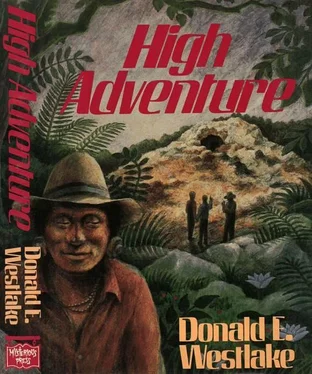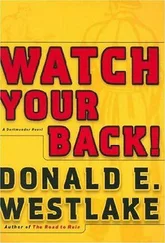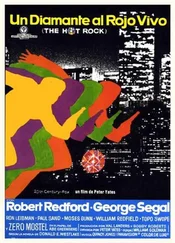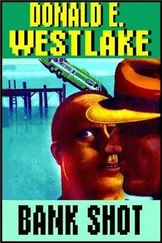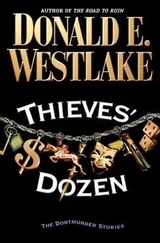“I deserve it,” Lemuel muttered, as he drove.

The next section of barbed wire fence beyond the red ribbon had fallen in, making access easy, so Lemuel was already out on the weedy spongy field when the airplane first appeared. It circled overhead, he waved, and down it came, landing at the opposite end of the field and roaring over to come to a stop just near where Lemuel was standing.
The door opened in its side as Lemuel came around the wing, and there was Kirby Galway clambering out, seeming in an awful hurry. In fact, the engines still ran, propellers spinning, plane all atremble to be off.
Galway looked at him in surprise. (There was someone else in the plane.) “Where’s Witcher and Feldspan?” he shouted, above the engine noise.
For some reason, Lemuel gestured behind himself, saying, “They went—”
“Still in the car? Okay, this is for them.”
“No, they—”
Galway turned back and wrestled with something in the seat behind the pilot’s, the other person helping. Lemuel stared, bewildered, and some sort of bale of hay came free at last, dropping out of the doorway, bouncing off the wing, landing on the ground at Lemuel’s feet. “What—”
“Sorry you’re getting it, too,” Galway told him, grinning, not looking sorry at all. “Tell your pals in the car, I know all about Trend.”
“Oh, my God. What have you—”
“Anonymous call to the DEA,” Kirby told him, with nasty satisfaction.
“The what? What’s that?”
“Drug Enforcement Administration,” Kirby said, and climbed back up into the pilot’s seat. “Sorry you’re here,” he called. “You should watch the company you keep.”
Which was when Lemuel recognized the second person in the plane, and it was Valerie Greene. “YOU!” he cried.
She nodded and smiled, with a little wave.
“Every time I see you something terrible happens!” Lemuel shrieked, pointing at the girl. Kirby pulled his door shut and the plane moved away. “This is the third time!” Lemuel screamed, following after, shaking his fist. “You’re a jinx !”
The plane picked up speed, leaving him. Lemuel stopped, suddenly panting for some reason. And now that the engine roar was receding, the plane was way over there lifting into the air, Lemuel could hear another sound, behind him, far in the distance.
Sirens.
Getting closer.
He turned and looked back toward the rental car parked on the little narrow dirt road, and his eye fell on the bale Kirby had pulled from the plane.
“That isn’t hay,” he said aloud.
Third time lucky.
26
Sailing Directions (En Route) for the Caribbean Sea
Valerie sewed with tiny stitches. Perched naked tailor-fashion on a beach blanket bearing a picture of Mickey Mouse surfing — seated mostly on his smile — she was up from the beach just far enough to be in the dappled shade of the coconut palms. Behind her, just visible through the ring-necked trunks of the trees, was the island’s only enclosed structure, a low house of unpainted concrete block with a slanted metal roof, flanked by the television satellite dish on the left and the electricity-generating windmill on the right. In front, the calm blue Caribbean folded itself time and time again on the beige sand.
Deceptively calm. The unnamed wee island on which Valerie sat and sewed the hem of a full white cotton skirt lay deep within the perimeter of a well-known nautical hazard, the Banco Chinchorro, about 16 miles off the Yucatan coast of Mexico, due west of Chetumal Bay. At latitude 18 degrees, 23 minutes north and longitude 87 degrees, 27 minutes west, and existing mostly just below the surface of the sea, the four-mile-wide area of Banco Chinchorro is described in the United States Government publication Sailing Directions (En Route) for the Caribbean Sea , which Valerie had looked at shortly after arrival here, as “a dangerous steep-to shoal” with “numerous rocky heads and sand banks. The stranded wrecks which lie along the E side of the shoal were reported conspicuous both visually and by radar.” This navigators’ guide finishes its description with a “ Caution . — In the vicinity of Banco Chinchorro there is usually a very strong current that sets toward its entire E side.”
Commercial shipping and pleasure craft alike steer well around Banco Chinchorro. And yet, on a few of its tiny islets, the beach is wide and clean, the sea is blue and gentle and nearly transparent, the air is warm and soft with a delicious easterly breeze. If you’d like to be alone with your sweetheart, there are few better spots on Earth than this.
Apart from Valerie herself, and the small house with its dish and windmill, the only other sign of human incursion on this island was Cynthia’s wheelmarks on the hardpacked sand, off to Valerie’s right. The first few times Kirby had flown down to San Pedro on the Belizean island of Ambergris Caye, 45 miles to the south, to pick up supplies or to be sure Innocent’s check had been deposited into their account (the bank branch in San Pedro is open three mornings a week), Valerie had flown with him, telling herself she needed the change, the opportunity to shop in the hotel boutique, walk around among other people, but in fact she didn’t need any of that at all. The truth was — and she soon realized this — the truth was, if she left the island with Kirby every time he was going somewhere, it meant she was afraid he wouldn’t come back, he’d strand her here. And that meant she didn’t trust him.
And if she didn’t trust him, what was she doing with him?
True, this life was a jolly and an easy one, particularly after all the running around just before they came here, but even more particularly after the total earnestness of her entire life prior to Belize. Thinking of that earlier self, of her earnest minister father and her earnest teacher brother, thinking of her own earnestness in pursuit of the dry joys of archaeology, she found it hard to believe she had spent so much time not being silly.
Not being silly.
What was the name of that book she’d read when she was a kid? Green Mansions. The idea inside that book had been an idea of fun, an idea of adventure and travel and strangeness and beauty, and what had she taken from it? In order to become Rima the bird girl, she had gone to college.
Not that college had been wrong for her, only that college had been wrong to be everything for her. A life circumscribed by the graves of the Mayas and the computers of UCLA is not a full life.
On the other hand, if she had always been too serious, Kirby had never been serious enough. They were good for one another, she felt. He took her out of herself — mm, yes, in several ways — he made her less self-consciously earnest and intense. At the same time, Valerie was leading Kirby slowly into the simpler forms and nearer waters of responsibility, showing him that a life spent in constant flight above the surface of things really isn’t very satisfactory in the long run.
And that was why, about three months ago, she’d said to him one day, “I don’t think I’ll come along to San Pedro this time. I want to do more digging on the other side of the island.” (There were traces of ancient occupation buried over there, bits of rubble that might have been pots, small pieces of charred wood. Toward the end of the Mayan civilization, after their great days of temple building, they had become merchants awhile, sailing their goods up and down the east coasts of Mexico and Central America, with outposts and warehouses on various islands along the way. Had this been one? Valerie was still an archaeologist.) .
Читать дальше
